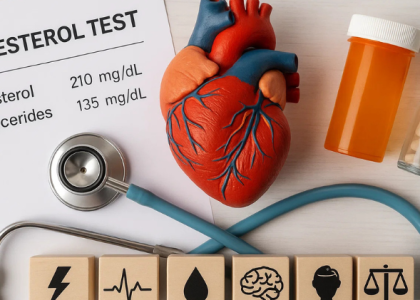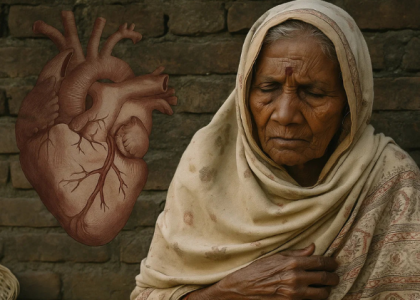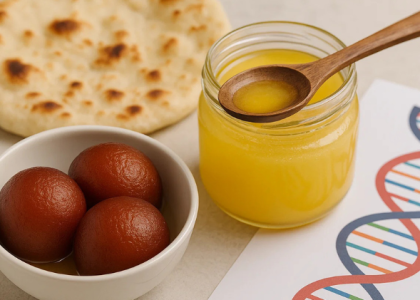High-heat cooking methods used in most South Asian kitchens may be creating hidden compounds that triple your risk of heart disease. The way we fry, roast, and reheat oil could explain why South Asians have heart attacks 5-10 years earlier than other groups.
Why This Matters for South Asians
South Asians have heart attacks 5-10 years earlier than other ethnic groups. For decades, doctors blamed genetics, diabetes, and stress. But researchers found another hidden cause: how we cook our food.
New studies show that high-heat cooking creates harmful compounds called Neo-Formed Contaminants (invisible chemicals that form when food gets very hot). These compounds damage blood vessels and increase heart disease risk.
The problem is not what we eat – our spices and ingredients are healthy. The problem is how we prepare them.
What Happens During High-Heat Cooking
When you heat food above 300°F (150°C), two harmful types of compounds form:
AGEs (Advanced Glycation End-products) – chemicals that form when proteins and sugars get very hot. They make food brown and tasty, but damage your blood vessels.
Trans Fats (TFAs) – harmful fats that form when oil is heated too high or reused many times. Unlike healthy fats, these clog your arteries.
These compounds cannot be seen or tasted. But they build up in your body over time.
How These Compounds Damage Your Heart
Blood Vessel Damage
AGEs stick to blood vessel walls and cause inflammation (swelling that damages arteries). This makes cholesterol build up faster.
Bad Cholesterol Gets Worse
Trans fats raise LDL cholesterol (bad cholesterol) and lower HDL cholesterol (good cholesterol). This doubles your heart attack risk.
Blood Becomes Stickier
These compounds make blood clot more easily. Sticky blood can block arteries to your heart or brain.
Higher Diabetes Risk
High AGE levels make your body resist insulin (hormone that controls blood sugar). This leads to diabetes, which damages your heart.
Why South Asian Cooking Creates More NFCs
Researchers compared South Asian cooking methods with Chinese cooking methods. Here’s what they found:
South Asian Cooking (Higher NFC Production):
- Deep frying: Pakoras, samosas, jalebis (300-375°F)
- Tandoor cooking: Naan, tandoori chicken (900°F)
- Pan frying: Most curries start with frying onions, garlic, spices
- Oil reuse: Same oil used multiple times for frying
- Long cooking times: Curries simmered for hours
Chinese Cooking (Lower NFC Production):
- Steaming: Dumplings, fish (212°F)
- Boiling: Soups, noodles (212°F)
- Quick stir-frying: High heat but very short time
- Braising: Cooking in liquid at lower temperatures
- Fresh oil: Less oil reuse
Cooking Method Comparison
| Cooking Method | Temperature | NFC Level | Common South Asian Foods | Heart Impact |
| Deep Frying | 300-375°F | Very High | Samosas, pakoras, puris | High risk |
| Tandoor/Roasting | 400-900°F | Very High | Naan, tandoori meats | High risk |
| Pan Frying | 200-300°F | High | Most curries, stir-fries | Medium risk |
| Pressure Cooking | 250°F | Medium | Dal, rice, vegetables | Lower risk |
| Steaming | 212°F | Low | Idli, dhokla, momos | Low risk |
| Boiling | 212°F | Very Low | Plain rice, simple dal | Very low risk |
The Numbers Don’t Lie
Research shows some alarming facts about South Asian foods:
High-NFC Foods Common in South Asian Diets:
- Jalebi: 17.7g trans fats per 100g serving
- Fried chicken: 9,722 AGE units per 100g
- Samosa: 3.3g trans fats per 100g
- Reheated cooking oil: 3x more trans fats than fresh oil
Low-NFC Foods Common in Chinese Diets:
- Steamed dumplings: 488 AGE units per 100g
- Chinese spring rolls: 0.14g trans fats per 100g
- Boiled chicken: 1,123 AGE units per 100g
Simple Ways to Reduce High-Heat Exposure
You don’t have to give up your favorite foods. Small changes can make a big difference:
1. Change How You Start Your Curries
Instead of: Frying onions, garlic, and spices in hot oil for 10 minutes Try: Steam or microwave onions until soft, then add a small amount of oil and spices for the last 2 minutes
2. Use the “Water Sauté” Method
How: Start with 2 tablespoons of water in your pan. Add onions and spices. Cover and cook until onions are soft. Then add 1 teaspoon of oil for flavor.
3. Steam Before You Fry
For vegetables: Steam vegetables until 80% cooked, then quickly stir-fry with spices for 2-3 minutes For meat: Pressure cook chicken or mutton first, then lightly brown it in a pan
4. Never Reuse Cooking Oil
Why: Each time you reheat oil, it creates more trans fats Solution: Use fresh oil each time, or invest in an air fryer for crispy foods with 90% less oil
5. Lower the Heat, Extend the Time
Instead of: High heat for fast cooking Try: Medium heat and cook a little longer. Your food will taste the same but have fewer harmful compounds
6. Add Acid to Reduce AGE Formation
How: Add lemon juice, tomatoes, or vinegar early in cooking. The acid helps prevent AGE formation even at higher temperatures.
Easy Swaps That Still Taste Great
For Breakfast:
- Instead of: Deep-fried puris → Try: Steamed idlis or baked rotis
- Instead of: Fried parathas → Try: Dry-roasted rotis with a little ghee added after cooking
for Snacks:
- Instead of: Fried samosas → Try: Baked samosas or steamed momos
- Instead of: Fried pakoras → Try: Steamed dhokla or air-fried vegetables
For Main Dishes:
- Instead of: Deep-fried fish curry → Try: Pan-steamed fish with curry sauce
- Instead of: Heavily fried dal → Try: Pressure-cooked dal with light tempering
Why This Matters for South Asian Families
The research shows that South Asians consume about 25% of their daily calories from fats and oils — much higher than other groups. Many of these fats come from high-heat cooking methods.
In well-off South Asian families, fat intake can be 3 times higher than in lower-income families. This might explain why heart disease appeared first in wealthy South Asian communities.
The good news? You have control over this risk factor. Food choices and cooking methods are something you can change, unlike genetics or family history.
Take Action: Protect Your Heart Today
You can keep your favorite flavors while protecting your heart. Start with these simple changes:
- Steam vegetables first, then add spices – This cuts harmful compounds by 80% • Use fresh oil every time – Never reuse cooking oil • Try water sautéing – Start with water, add oil at the end for flavor • Cook at medium heat longer – Lower heat, more time = same taste, less damage
Small changes in your kitchen can prevent big problems for your heart. Your family’s health is worth making these adjustments.
Learn More: “Heart-Healthy South Asian Recipes” – Get 20 traditional recipes modified for better heart health
Sources:
- Kakde S, Bhopal RS, Bhardwaj S, Misra A. “Urbanized South Asians’ susceptibility to coronary heart disease: The high-heat food preparation hypothesis.” Nutrition, 2016. https://doi.org/10.1016/j.nut.2016.07.006
- Vlassara H, Uribarri J, Ferrucci L, et al. “Identifying advanced glycation end products as a major source of oxidants in aging: implications for the management and/or prevention of reduced renal function in elderly persons.” Seminars in Nephrology, 2009. https://pubmed.ncbi.nlm.nih.gov/19371803
Micha R, Mozaffarian D. “Trans fatty acids: effects on metabolic syndrome, heart disease and diabetes.” Nature Reviews Endocrinology, 2009. https://pubmed.ncbi.nlm.nih.gov/19352320




